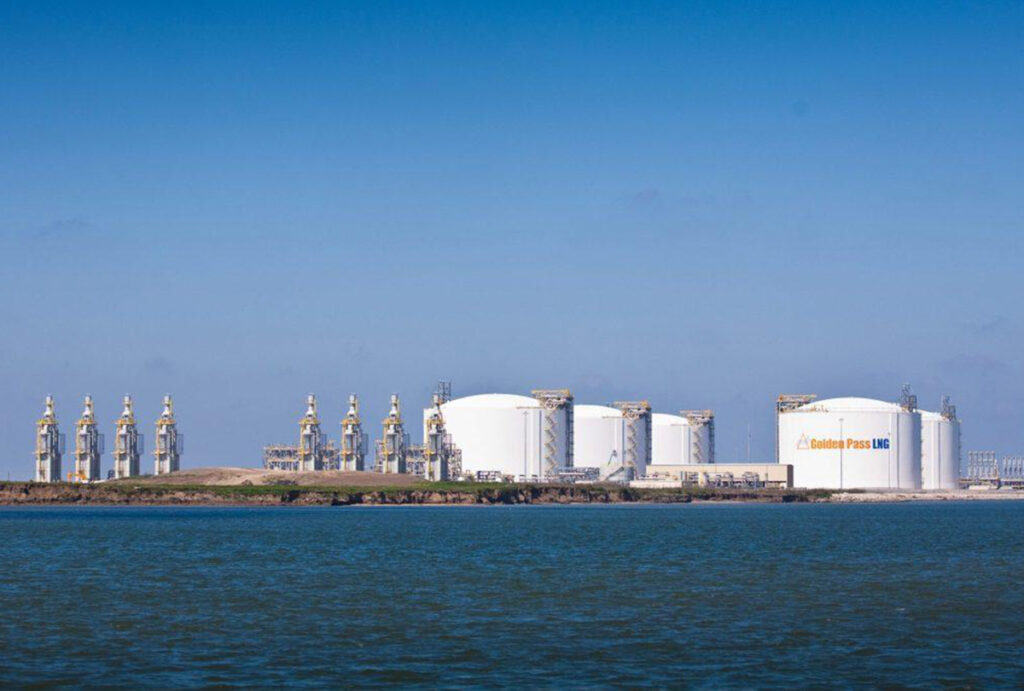Despite vast responsibly produced natural gas resources, Canada’s LNG future uncertain due to challenges getting projects built
Follow CEC on Linkedin CEC Linkedin
Follow CEC on Facebook CEC Facebook
Follow CEC on Twitter CEC Twitter

Exxon Mobil’s US$10 billion Golden Pass LNG project on the Texas coast has its workforce working 24 hours a day, seven days week in order to open in the second half of 2024. Photo courtesy Golden Pass LNG
The United States continues its massive build out of LNG export capacity as a second major project looks to move to 24/7 construction.
Meanwhile, analysts say Canada is a “dark horse” with an uncertain LNG future due to challenges getting projects built.
“The outlook for LNG is bullish, with another 100 million tonnes per annum of capacity required to meet demand growth by the mid-2030s,” consultancy Wood Mackenzie said in a July research note. That’s about 25 per cent more LNG needed on top of projects already going ahead, analysts said.
Global LNG trade hit a new record last year, driven in part by European nations buying up supplies to replace pipeline imports from Russia, according to the U.S. Energy Information Administration (EIA).
The U.S. is expanding its LNG exports faster than anywhere else in the world – growing by 16 per cent in 2022 alone, the EIA reported.
America’s seven operating terminals exported 76 million tonnes of LNG to global markets last year, according to with Wood Mackenzie. There are five new terminals under construction.
One of them, Exxon Mobil’s US$10 billion Golden Pass LNG project on the Texas coast, received regulatory approval to increase its workforce by nearly 5,000 people and move construction to 24 hours a day, seven days week, to meet its target in-service date in the second half of 2024.
Now Venture Global has asked FERC to allow it to also work 24/7 at the Plaquemines LNG project in Louisiana, increasing its workforce to 6,000 from 3,600 under the current approval. This will help it start exports by the end of 2024, the company said.
Wood Mackenzie analysts report the U.S. and its main competitor, Qatar, are likely to see the most growth in LNG exports in the coming years. It is unclear how much Canada will fit in.
“West Canada is a dark horse. The challenges for building out new capacity are clear. Construction costs are high in Canada, not least for new pipelines across the Rockies. Support from Canadian First Nations is critical to secure social licenses. But Canada also has much in its favour,” Wood Mackenzie said.
This includes huge resources of “responsibly sourced gas,” or natural gas that has been certified by independent third parties as having a lower environmental footprint; multiple producers including Asian companies eager to sell LNG; lower cost of supply; and closer proximity to Asian markets than projects on the U.S. Gulf Coast.
Canada is coming closer to entering the global LNG market. The first project, LNG Canada, is now 85 per cent complete and expected to start running in 2025. Smaller Woodfibre LNG is slated to start construction in September, and the Indigenous-led Cedar LNG project targets a go-ahead decision before winter.
Removal of policy and regulatory impediments could see Canada become the world’s fifth-largest LNG exporter by 2035, according to CEC Research.
The unaltered reproduction of this content is free of charge with attribution to Canadian Energy Centre Ltd.
Share This:





